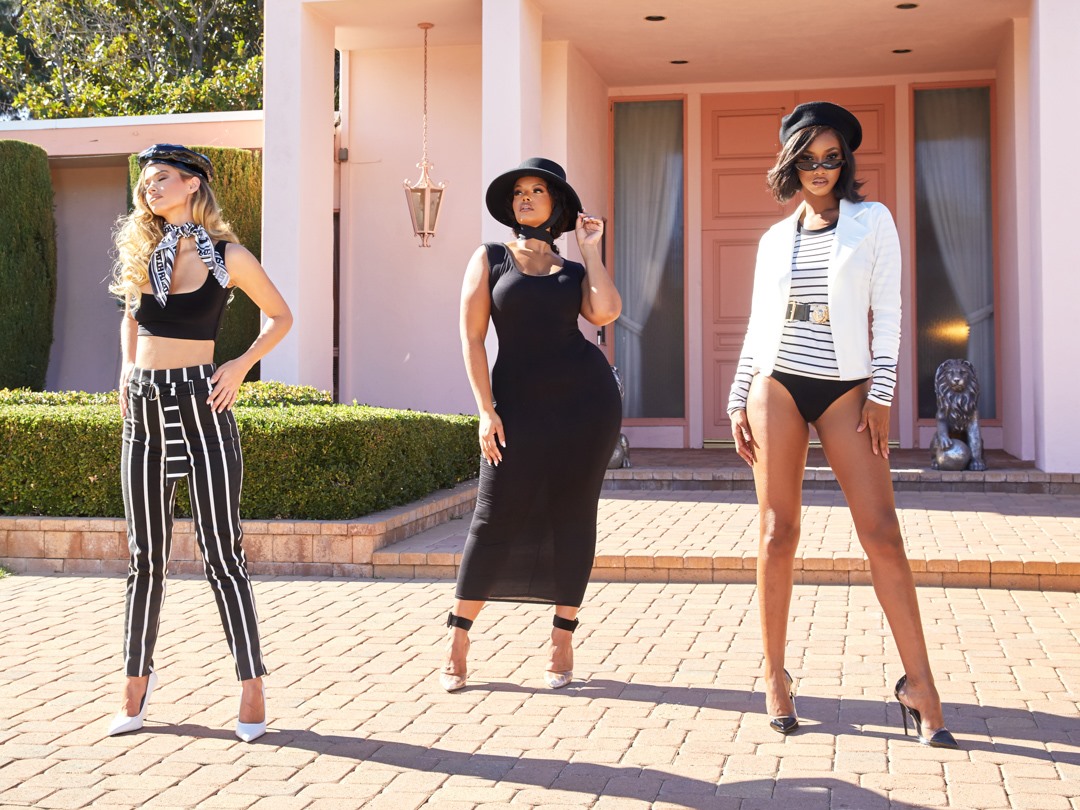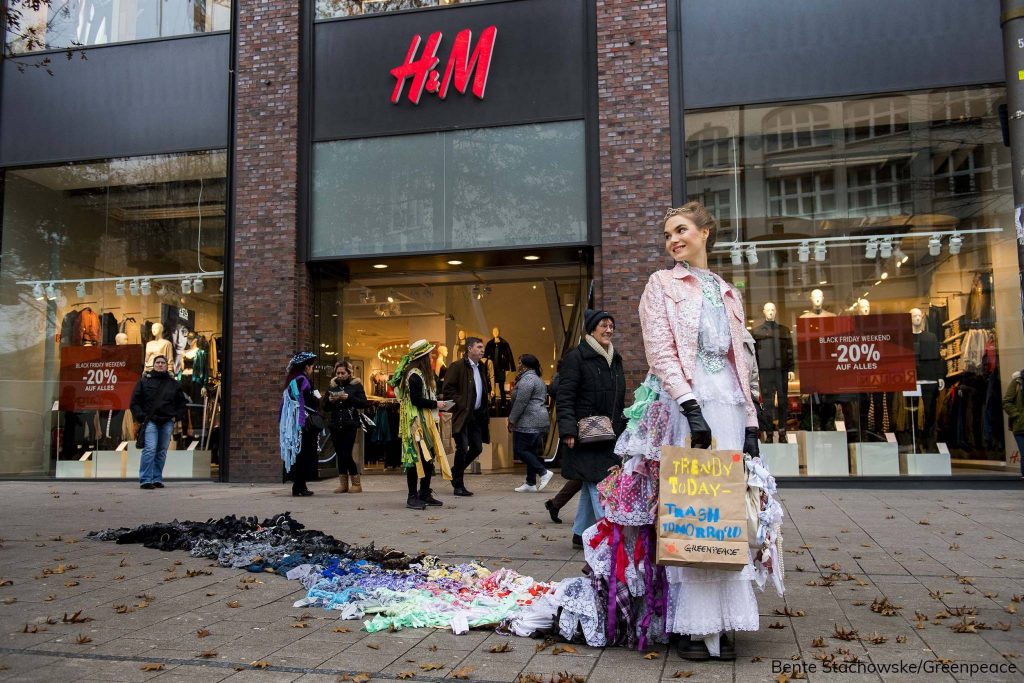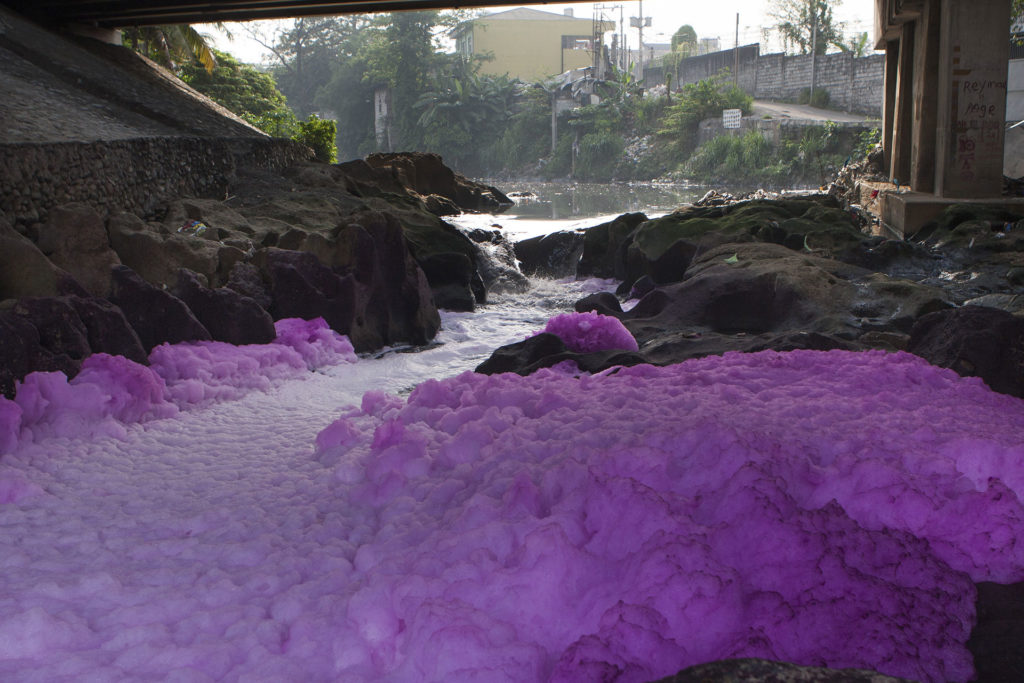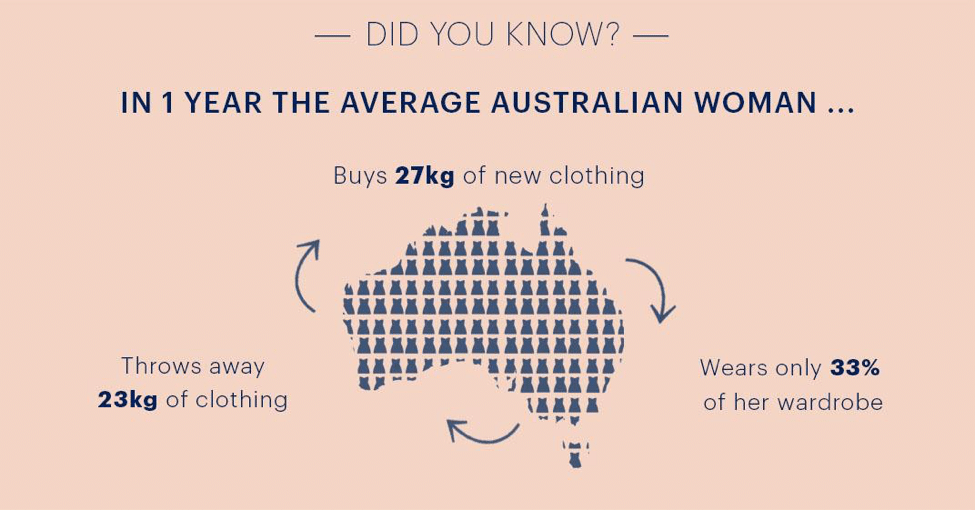Fast Fashion.
We buy it, wear it once or twice, get sick of it—or realise it’s gone out of fashion—and throw it in the bin, destined for landfill, only to begin the cycle all over again.
Unfortunately, the affordability and accessibility of fast fashion comes at a steep price for the planet and the people who make it.
There are roughly 40 million garment workers in the world today, 85% of them women, who are some of the lowest paid workers in the world. Fast fashion is also a major contributor to greenhouse gases, water, and air pollution, and creates problematic levels of waste.
Image via Pretty Little Thing

We’re increasingly disconnected from the people who make our clothes and how our fashion choices are impacting the planet – and it’s a huge problem.
What is Fast Fashion?
According to the Dictionary, fast fashion is “an approach to the design, creation, and marketing of clothing fashions that emphasizes making fashion trends quickly and cheaply available to consumers.”
In others: fast fashion is trend driven, cheap, poorly made, easy-to-purchase clothing.
While this phrase has taken on a negative connotation due to large clothing companies exploiting workers and harming the environment, its origin is far less sinister.
Fast fashion has been a concept since the 1800s when factories replaced the slow process of making clothing at home or purchasing it from tailors.
A quick history lesson
The Industrial Revolution saw the start of fast fashion, “which introduced new textile machines, factories, and ready-made clothing, or clothing that is made in bulk in a range of sizes rather than being made to order.”
This trend continued well into the 1900s, though average citizens and tailors still played a significant role in making clothing. The 1960s saw fast fashion ramping up as people felt the need to keep up with fashion trends.
By the 1990s, the concept reached its peak with companies such as H&M, Zara, Walmart, and Target selling cheap, disposable clothing by the billions.
Today, fast fashion is the norm for the majority of clothing retailers. In Australia, where the demand for textiles is one of the highest per capita in the world, the fast fashion sector grew by 19.5 percent over five years to $AUS1.8 billion in 2017-18.

Why is Fast Fashion a problem?
Overconsumption
Global clothing production has doubled in the past 15 years, with clothes on average being worn much less and discarded quicker than ever before. Globally, we now consume about 80 billion new pieces of clothing every year, 400% more than we were consuming just two decades ago. Jane Milburn of Textile Beat says,
“Australia is the second-largest consumer of new textiles after the US, averaging 27 kilograms of new textiles every year.”
It’s a 2.5 trillion dollar industry, and it’s not slowing down.
Poverty and human rights abuses
When the Rana Plaza garment factory in Bangladesh collapsed in 2013, the world was horrified—for a moment.
Over 2500 of the factory workers were injured, and 1135 were killed. 80% of the garment workers caught inside that day were women. They were mostly young, 18 – 20 years old, and forced by poverty to work in the factory for around 22 cents an hour.
It was supposed to be a wakeup call for the fashion industry but six years on, has anything really changed?
Based on hundreds of interviews with garment workers in Bangladesh and Vietnam for Oxfam’s’ Made in Poverty Report, the research shows appallingly low wages in the garment sector are trapping workers and their families in a cycle of poverty.
Nine out of ten workers interviewed in Bangladesh cannot afford enough food for themselves and their families, forcing them to regularly skip meals and eat inadequately, or go into debt. Australian fashion brands are an integral part of the system that keeps these women trapped in poverty.
Global Labour Justice found female garment workers in Bangladesh, Cambodia, India, Indonesia, and Sri Lanka, suffer harassment and physical and sexual abuse daily. Most of these cases are not reported due to fear of retaliation in the workplace or losing their jobs.

Residents along Tullahan river have noted a multi-coloured effluent in the river water, rocks and banks. Several industries, such as paper, pen and dye factories, are located upstream from this site. © Gigie Cruz-Sy / Greenpeace
Environmental pollution
The environmental impact of fast fashion is enormous.
The fashion industry emits more carbon than international flights and maritime shipping combined.
Synthetic materials, toxic dyes, hazardous chemicals, pesticides, wastewater, and textile waste. Cheap clothes come at a high environmental cost. In 2011 Greenpeace launched its “Detox My Fashion” campaign to address this problem, asking the fashion industry to take responsibility urgently.
- Fast fashion garments, which we wear less than five times and keep for 35 days, produce over 400% more carbon emissions per item per year than garments worn 50 times and kept for a full year.
- Twenty thousand litres is the amount of water needed to produce one kilo of cotton; equivalent to a single t-shirt and pair of jeans.
- Cotton represents nearly half of the total fiber used to make clothing today. More than 90% of that cotton is now genetically modified, using vast amounts of water as well as chemicals. Cotton production is now responsible for 18% of worldwide pesticide use and 25% of total insecticide use.
- Nearly 70 million barrels of oil are used each year to make the world’s polyester fiber, which is now the most commonly used fiber in our clothing. But it takes more than 200 years to decompose.
- 85% of the plastic pollution in the ocean is due to microfibers from synthetic clothing.
Ultimately, fast fashion a consumer-driven market, and while there’s still a demand for fast, cheap clothing, fashion brands will continue to make it.

What’s the alternative?
Fast fashion is appealing because, well, it’s cheap.
A $20 pair of jeans versus a $200 ethically made pair, seems like the obvious choice for most. It’s also tough to love our clothes and want to keep wearing them for longer when fashion stores have new styles dropping almost daily, and we’re constantly bombarded with powerful marketing telling us what we ‘need.’ Buying responsibly made clothing also often comes with a higher price tag.
But, there are ways to make ethical and sustainable clothing choices without breaking the bank.
Buy Preloved or Rent
According to thredUP’s 2019 Resale Report, the demand for second-hand fashion is set to overtake fast fashion within the next ten years. In 2018, the secondhand market accounted for $28 billion, compared to $35 billion for fast fashion and in ten years, the secondhand market is expected to reach $64 billion. Buying pre-loved clothing is an earth-friendly and affordable way to avoid buying fast fashion.
Where to buy preloved
- eBay
- Gumtree
- Vestiare Collective
- The Real Real
- thredUP
- Poshmark
Imagine having access to a wardrobe of thousands of designer dresses, bags, and accessories available to you at a click of a button, for a mere fraction of the price and delivered to your front door. This concept of sharing and exchanging clothes is nothing new. Women have been doing this for centuries.
Where to rent
Shop your wardrobe or Swap
Is your wardrobe an abyss with pieces that haven’t seen the light of day for years? Before you go to buy anything new, go shopping inside your own wardrobe, you’ll probably find you already have what you planned to buy. Wear old things new ways, invite a friend over and ask them to help you style pieces in ways you hadn’t previously thought of. You really can repurpose what you have.
Attend or host a clothing swap. It’s a great, sustainable and free way to score some new clothes while discarding some old ones responsibly. Check out the Global Fashion Exchange and The Clothing Exchange for swaps near you.
Slow Down and Invest in Quality
Invest in well-made clothes from ethical fashion brands, pieces you know you’ll love and wear for many years. These pieces often come with a higher cost, so you’re more likely to stop and think if you actually need it. Our Brand Directory helps you discover brands that align with your values.
Finally, invest in what you already own.
So many of us are guilty of throwing clothes away as soon as they’re damaged. Get yourself a great seamstress, bag, and shoe repair person on speed dial and give life back to something you once loved. It’s worth spending a little bit of money on getting things fixed rather than re-buying the same thing again.
Deal with your unwanted clothes responsibly
There are several ways you can recycle your used clothing.
- Donate – Op shops like Salvos and Vinnies will accept your old threads BUT remember the general rule; if you wouldn’t give it to a friend, then it’s not in good enough condition to donate.
- Sell them on eBay, Gumtree or consignment shops
- Repurpose – Pinterest is a great place to discover ways you can repurpose old clothing—from turning sweaters into purses and t-shirts into blankets.


